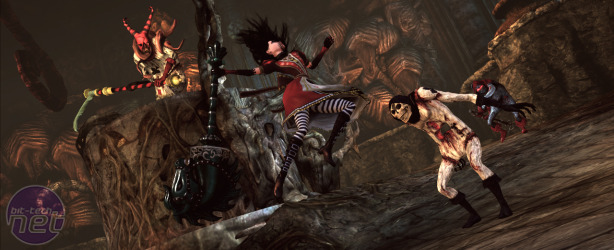
Alice: Madness Returns PC Review
While it’s of course worth highlighting the niggles of Alice’s controls for the mechanically-minded, it also has to be emphasised that the issue isn’t an insurmountable one. Alice’s occasionally unpredictable dodging distance is, like the speed at which her pepper-mill machine overheats, a slight annoyance rather than a game-breaking issue.Instead, what really is worth focusing on is the amount of imagination that’s been ploughed into Alice’s escapade, with Madness Returns often providing entertaining twists on both the fiction at hand and the conventions of modern games. Alice’s adversarial relationship with the Cheshire Cat is an excellent example of how Lewis Carroll’s works are inverted to great effect, while the way that crouching has been replaced with shrinking showcases the latter point.
Shrinking, in fact, is used for more than just navigating through keyholes and tree trunks – it also provides a new perspective for Alice, highlighting hidden paths and otherwise invisible graffiti that decorates the level. Shrinking violet flowers and messages from the Cheshire Cat help highlight some occasions when a drop in stature might be useful. Elsewhere, flying pig snouts can be sprayed with pepper to sneeze other hidden paths into existence.
In some places, however, gaming tropes are less cannily hidden – and are sometimes incongruously displayed, in fact. Throughout her adventure in Wonderland, Alice is encouraged to collect several different types of item and while some, such as memory fragments that offer momentary insights into Alice’s past, fit in appropriately, others don’t fit as neatly. The fact that pearly white teeth litter Wonderland and can be collected to upgrade weapons is all well and good for balancing, but never really feels like a part of Alice’s insanity.
Indeed, weapons are a recurring weak point for Alice, as the deliciously bewildering jumble of creatures often requires players to move away from favoured armaments to use more recently acquired tools. The Vorpal Blade, with its blue-red trails and vicious attack chains, was our favourite and most upgraded weapon from early in the game. Thus, being forced to rely on other weapons in order to tackle even early enemies, such as mechanical teapots in the Mad Hatter’s realm, was a pain, especially when it takes hundreds of teeth to upgrade weapons by even one level.
Check the Game Trailers section for more videos
However, while these issues certainly grate – as does the frustration of juggling the lock-on camera with a keyboard layout – they, again, aren’t enough to spoil the game. Whenever problems such as weapon balancing or shoddy voice-acting start to crop up, it’s always possible to take a deep breath and look at the game again; it’s just so goddamn pretty.
This prettiness, more than even the intelligent merging of new and old fiction underneath, is what defines Alice: Madness Returns. If Alice were any less of a spectacle then there’s little doubt that we would find other complaints – no multiplayer, in this day and age? As it is, though, it’s hard to care about many of these issues. It’s just too pretty, especially when it’s coupled with a story that’s intelligent and interesting when compared to most modern titles.
Here is a game that uses metaphor and wit to weave a story in which a demented young girl does battle with robotic march hares. It may still gyre and gimble along the wabe, which stops it from being truly frabjous, but it’s still brillig in its own right.
-
Overall80 / 100


MSI MPG Velox 100R Chassis Review
October 14 2021 | 15:04










Want to comment? Please log in.